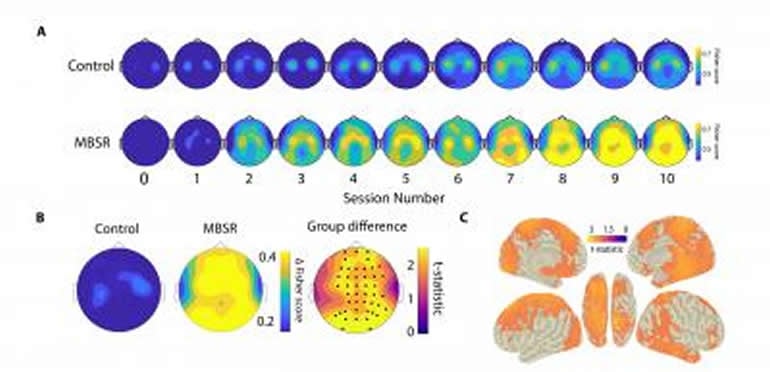Seminar Papers

The team found that those with training in mindfulness-based attention and training (MBAT) were more successful in controlling the BCI, both initially and over time. Interestingly, the researchers found that differences in brain activity between the two sample groups corresponded directly with their success. The meditation group showed significantly enhanced capability of modulating their alpha rhythm, the activity pattern monitored by the BCI system to mentally control the movement of a computer cursor.
His findings are very important for the process of BCI training and the overall feasibility of non-invasive BCI control via EEG. This work shows that just a short period of MBAT training can significantly improve a subject’s skill with a BCI. This suggests that education in MBAT could provide a significant addition to BCI training.
https://neurosciencenews.com/meditation-mind-control-17071/
Mindfulness Improves Brain–Computer Interface Performance by Increasing Control Over Neural Activity in the Alpha Band James R Stieger, Stephen Engel, Haiteng Jiang, Christopher C Cline, Mary Jo Kreitzer, Bin He

Researchers have uncovered the neural mechanism underlying rumination. The study reports when rumination occurs, coupling between the core and medial temporal lobe subsystems of the default mode network becomes elevated while coupling between the core and dorsomedial prefrontal cortex decreases. According to this study, they computed the Pearson’s correlation during the activity among different brain regions. Results revealed that couplings between the core and the medial temporal lobe (MTL) subsystems of the default mode network (DMN) were elevated while the other couplings were decreased.

Researchers conducted a first-of-its-kind study designed to investigate brain connectivity in 130 mammalian species. The intriguing results, contradicting widespread conjectures, revealed that brain connectivity levels are equal in all mammals, including humans.
Their study revealed a universal law: Conservation of Brain Connectivity which denotes that the efficiency of information transfer in the brain’s neural network is equal in all mammals, including humans. They also discovered a compensation mechanism which balances the connectivity in every mammalian brain. This mechanism ensures that high connectivity in a specific area of the brain, possibly manifested through some special talent (e.g. sports or music) is always countered by relatively low connectivity in another part of the brain.
In future projects they will investigate how the brain compensates for the enhanced connectivity associated with specific capabilities and learning processe.
https://www.sciencedaily.com/releases/2020/07/200720112216.htm
Yaniv Assaf, Arieli Bouznach, Omri Zomet, Assaf Marom, Yossi Yovel. Conservation of brain connectivity and wiring across the mammalian class. Nature Neuroscience, 2020; 23 (7): 805
The authors reviewed recent work in the intersection of cognitive science, computational neuroscience and artificial intelligence. Computational models that mimic brain information processing during perceptual, cognitive and control tasks are beginning to be developed and tested with brain and behavioral data.
https://www.nature.com/articles/s41593-018-0210-5
N. Kriegeskorte, P.K. Douglas. Cognitive computational neuroscience. Nat. Neurosci., 21 (2018), pp. 1148-1160
A research team recently found new evidence revising the traditional view of the primate brain’s visual system organization. This remapping of the brain could serve as a future reference for understanding how the highly complex visual system works, and potentially influence the design of artificial neural networks for machine vision. (from the below link)
https://www.sciencedaily.com/releases/2019/08/190821113151.htm
Bing‐Xing Huo, Natalie Zeater, Meng Kuan Lin, Yeonsook S. Takahashi, Mitsutoshi Hanada, Jaimi Nagashima, Brian C. Lee, Junichi Hata, Afsah Zaheer, Ulrike Grünert, Michael I. Miller, Marcello G. P. Rosa, Hideyuki Okano, Paul R. Martin, Partha P. Mitra. Relation of koniocellular layers of dorsal lateral geniculate to inferior pulvinar nuclei in common marmosets. European Journal of Neuroscience, 2019; DOI: 10.1111/ejn.14529